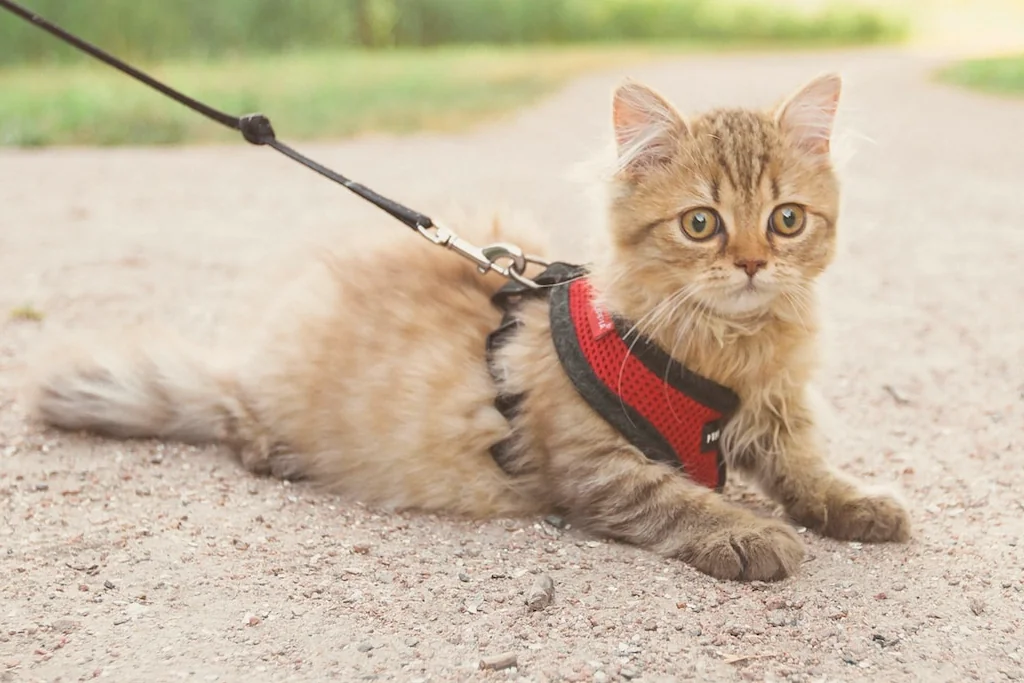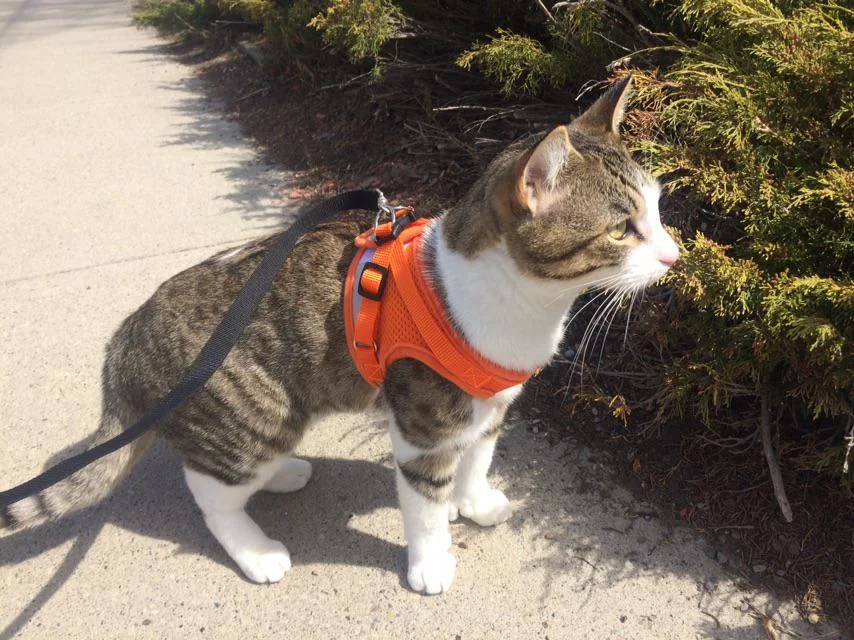Note: We may earn a commission from helpful, relevant links in our content. No cost to you. See our privacy policy.
Ever felt like your indoor cat is yearning for some fresh air?
Or perhaps you’re grappling with the challenges of relocating a previously outdoor cat to a safer, indoor environment? We get it, and that’s exactly why we’re here. Leash training your cat might be the answer to these problems, but it’s more than just a solution.
It’s about broadening your cat’s horizons while keeping them safe and secure. So buckle up and get ready to realize the potential of harness and leash training for your feline friend.

Why Leash Train Your Cat?
Leash training goes beyond just solving dilemmas. It gives your cat the freedom to explore the outdoors in a controlled and safe manner.
Plus, it offers a great bonding opportunity for you and your feline companion. This outdoor exposure can stimulate your cat’s senses, providing both physical exercise and mental enrichment.
It’s not about merely curbing indoor boredom, but enriching your cat’s life. It’s about granting them safe access to a world they’re naturally curious about.
How to Choose the Right Harness for Your Cat?
Choosing the right harness for your cat can make a world of difference.
First, consider your cat’s size, weight, and comfort. The harness should fit snugly, but it shouldn’t restrict movement or be too loose to slip off. It’s crucial to select a style that your cat will accept – the two main types being the “H-style” and the “Figure 8”.
For larger, more active cats, the ‘H-style’ harness can provide a better fit and more control. A popular pick is the ‘PetSafe Come With Me Kitty Harness’ which offers adjustable straps for a custom fit.
On the other hand, the ‘Figure 8’ type, like the ‘Kitty Holster Cat Harness’, is often preferred for its ease of use and soft material. It’s ideal for smaller cats or those with sensitive skin.
Remember, choosing the right harness is a key step towards a successful leash training experience, and it should suit both your cat’s physical needs and their personality.
Thinking of using your dog’s collar for your cat? Think twice.
Making Friends with the Harness: How to Get Your Cat Comfortable?
Getting your cat comfortable with the harness is a delicate process, but with patience, it can be done.
Begin by letting your cat sniff and explore the harness. Place it near their favorite lounging spot or even rub it with a soft blanket they like to curl up on. This way, the harness starts to smell familiar and less threatening.
Next, try laying the harness gently on your cat without fastening it. Give them a treat and some praise, reinforcing the idea that the harness is associated with good things. If your cat is okay with it, you can proceed to fasten the harness loosely. Remember, always keep these sessions short and positive.
Here’s a unique trick – distract your cat with their favorite interactive toy or a game of chase while they have the harness on. It’ll take their mind off the unfamiliar feeling and, before they know it, they’ll be associating it with fun times.

Leash Training: Where to Start?
The moment your cat is comfortable with wearing the harness, it’s time to introduce the leash.
Let your cat explore the leash just as you did with the harness. Attach it to the harness and allow your cat to roam indoors with it. Supervise these sessions to ensure they don’t get tangled.
Now, here’s where my experience comes in handy – before venturing outdoors, practice guiding your cat with the leash indoors. Use a cue word such as “come” or “let’s go”, followed by a gentle tug on the leash. Reward them when they follow your cue to reinforce the behavior.
This way, your cat starts to understand the signals you want them to follow.
The next step is to venture outside. Start with a quiet, secure space like your backyard. Remember, the outdoors can be overwhelming for an indoor cat, so keep initial outings short. Let your cat set the pace and decide where to explore.
Leash training isn’t about control but about providing your cat a safe way to explore the outside world. Patience and consistency are key here. The road to leash training might be lengthy, but the reward of shared outdoor adventures with your cat is worth every step.
Common Challenges and How to Overcome Them
Leash training your cat isn’t always a smooth sail, and you may encounter some common challenges.
Perhaps the most frequent one is the cat freezing or flopping over when the harness is on. It’s their way of saying, “What is this thing on me?” Don’t worry, it’s normal. Start by having shorter sessions with the harness, slowly increasing the time as your cat gets accustomed to it.
Another challenge is leash resistance. Cats are independent creatures and might not take kindly to the leash initially. Here, the key is to make the leash feel as unrestrictive as possible. Let your cat lead the way during your initial walks. This gives them a sense of control, reducing their resistance over time.
Now, let’s talk about something most trainers miss – harness aversion due to past trauma. I discovered this with my male cat, Smokey. I had a hard time making Smokey wear the harness until I realized that his previous owners might have used a similar-looking harness to control him. I switched to a different style, and voila, the problem was solved!
Therefore, if your cat exhibits extreme fear or aggression with the harness, it might be worth consulting a vet or a pet behaviorist to rule out any past trauma.
FAQs
Can all cats be trained to walk on a leash?
While most cats can be trained to walk on a leash, each cat is unique and some may not adapt to it due to age, temperament, or past experiences. It’s always recommended to understand your cat’s comfort and boundaries.
What type of harness is best for training a cat?
An “H-style” or “Figure-8” harness is usually the best for training a cat. These models distribute pressure evenly over the cat’s body and reduce the chance of escape.
When to start leash training my cat?
It’s generally easier to start leash training when your cat is still a kitten, as they are more adaptable to new experiences. However, adult cats can be trained too with patience and consistent practice.
My cat doesn’t like the harness. What should I do?
Start by letting your cat familiarize themselves with the harness. Associate it with positive experiences like treats and playtime. If they still resist, consider trying a different style or fit of harness that may be more comfortable for them.
Alex, a passionate animal lover, has experience in training and understanding animal behavior. As a proud pet parent to two dogs and three cats, he founded AnimalReport.net to share insights from animal experts and expand his knowledge of the animal kingdom.









